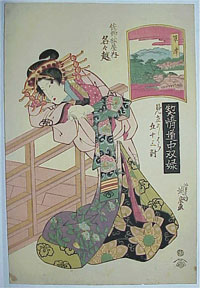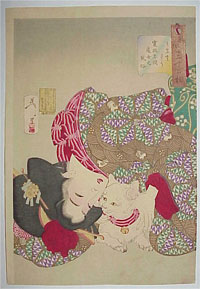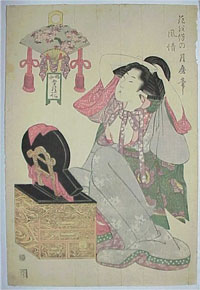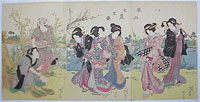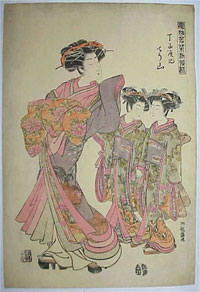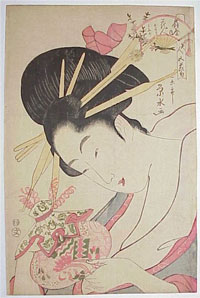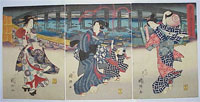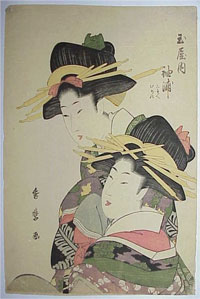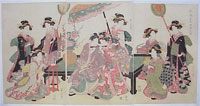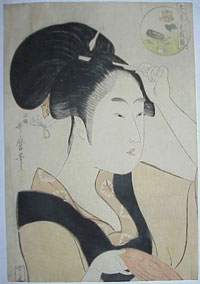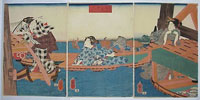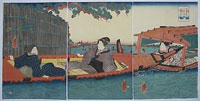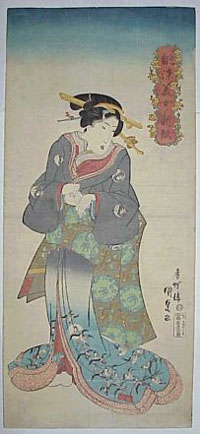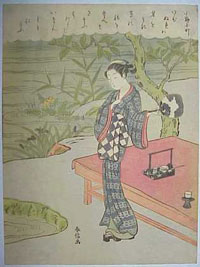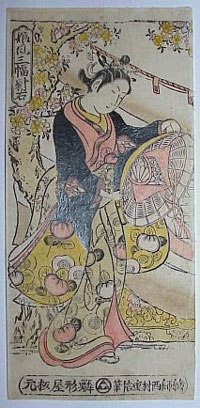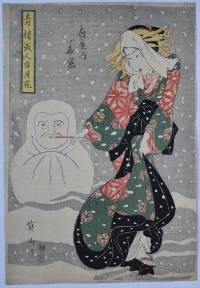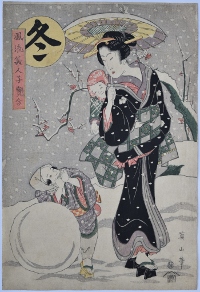/category/beauties/page/4/
Suzuki HARUNOBU (1724-1770)
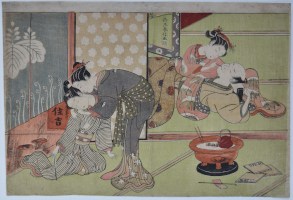
Click here to view image full size.
Two couples in a brothel. The young man near the entrance seems in need of a lot of encouragement. The name written on the left of the entrance is Sumiyoshi. A chuban yokoe design published c 1769-70. Another impression is in ROM, 926.18.121.
Very good impression and colour. Minimal soil, otherwise good condition. Signed Suzuki Harunobu ga on the rear screen.
Status: Sold
Keisai EISEN (1790-1848)
Click here to view image full size.
The courtesan Nanakoshi of Sano Matsu-ya. Station Kusatsu from a series parodying Yoshiwara courtesans with the 53 Stations of the Tokaido; the set seen as a sugoroku game, the winner gaining the lover. The set published by Tsutaya Kichizo, c late 1830s.
Fine impression and colour. Small stain lower left corner and minor marks, but otherwise very good condition. Signed Keisai Eisen ga.
Status: Sold
Taiso YOSHITOSHI (1839-1892)
Click here to view image full size.
Noisy. A young woman of the Kansei period playing with a cat from the set Fuzoku sanjuniso, the “Thirty-Two Types of Beauty in Daily Life” published by Tsunashima 1888. One of the most sought after designs from the set. The first edition.
Very fine impression and colour. Full size with the extra paper left and top. Signed Yoshitoshi ga.
Status: Sold
Kitagawa TSUKIMARO (FI.?-1830)
Click here to view image full size.
A bijin adjusting her hair before a mirror from a set: Hana no kazari no fuzei, “Elegance of the Flower Decoration”. Published by Tsuru Kin c1810’s.
Very good impression and colour. Minor marks: slight edge nibbling and the paper laid-lines evident top and bottom, but otherwise very good. Signed Tsukimaro hitsu.
Status: Sold
Keisai EISEN (1790-1848)
Click here to view image full size.
A triptych entitled Fuzoku shi-nho-ko sho, “The Customs of Different Classes, Samurai, Farmers, Artisans and Tradesmen”. Published by Kawaguchiya Uhei c.1820s.
Very good impression, perfect colour. Original album backing. Fine condition. Signed Keisai Eisen ga.
Status: Sold
Isoda KORYUSAI (Fl.c.1764-1788)
Click here to view image full size.
The courtesan Chozan of Choji-ya from the series: Hinagata Wakana no hatsu-moyo, “Models for Fashions: New Designs as Fresh as Young Leaves”. The set published c.1782. Printed on heavy hosho.
Fine impression. Exceptional colour for a print of this series and date. Expert edge repair at centre left and slight signs of mounting au verso around edge, but otherwise a fine example. Signed Koryusai ga.
Status: Sold
Ichirakutei EISUI (active 1789-1804)
Click here to view image full size.
Excessively rare bust portrait of the courtesan Hanahito of the Ogi-ya. The Doll Festival from a set of the Five Seasonal Festivals published by Maru-ya Bun’emon, c.1798. The British Museum impression of this print is illustrated in Ukiyo-e Masterpieces in European Collections, no.205.
Very good impression and colour. Slight soil and creasing but overall a nice example of this uncommon artist’s work. Signed Ichirakutei Eisui ga.
Status: Sold
Utagawa KUNISATO (?-1858)
Click here to view image full size.
Female figures and a child against a backdrop of the Sumida River and the Ryogoku Bridge. Azuma meisho Ryogokubashi yugeshiki. Published by Maru-ya Kiyojiro, Hare 2 (1855).
Very good impression and colour. Minor soil and wormage, otherwise very good condition. Signed Ritsusensai Kunisato ga.
Status: Sold
Nishikawa SUKENOBU (1671-1751)
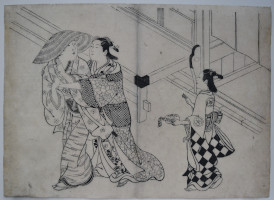
Click here to view image full size.
A client taking leave from his paramour, her assistant stands back holding small presents. Sukenobu was born, lived and died in Kyoto. Apart from some paintings and prints, his extensive output was in the form of illustrated books, and albums. The example here is from one of these albums. Always in sumi, without colour.
Very good impression. Some expertly repaired wormage and centre fold (as usual).
Status: Sold
Kitagawa HIDEMARO (active circa early 19th century)
Click here to view image full size.
A pupil of Utamaro who produced some fine work at the turn of the century. An aiban double bust portrait of the courtesan Sodenoura of the Tamaya House and her kamuro. Published c1810s.
Fine impression and colour. Minor creases and several small backed wormholes, but overall lovely, fresh design. Full size. Signed Hidemaro ga.
Status: Sold
Ichiryusai HIROSHIGE (1797-1858)
Click here to view image full size.
A chuban triptych showing three beauties relaxing at Takanawa from a set of Eight Views of Edo. Published by Joshuya Kinzo c.1849-50. (Tamba no.146.)
Very good impression, colour and condition. Signed Hiroshige ga.
Status: Sold
Isoda KORYUSAI (1735-1790)
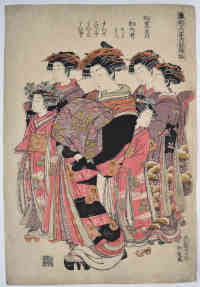
Click here to view image full size.
The courtesan Matsunoi of the Matsubaya with her kamuro. From a large series Hinagata wakana no hatsu moyo, “Models for Fashion: New Year Designs as Fresh as Young Leaves.” Published by Eijudo and Juzaburo in the late 1770s. This set is the largest known bijin series (140 prints being known). However, the quality is consistent throughout. One of the great sets.
Fine impression with excellent colour. Minor soil, otherwise very good condition. Signed Buko Yagenbori inshi, Koryu ga.
Status: Sold
Kikugawa EIZAN (1787-1867)
Click here to view image full size.
A complete triptych showing young girls in attendance on a court couple. An early (c.1820) design published by Nishimuraya Yohachi.
Very good impression, colour and condition. Full size with extra paper for joining. Signed Eizan fude.
Status: Sold
Ichiyusai KUNIYOSHI (1797-1861)
Click here to view image full size.
An extremely rare chuban triptych from a set of the Four Seasons, this being “Winter”. Seemingly the only other illustrated example is in Kuniyoshi, Juzo Suzuki, Tokyo, 1992, which shows all four from the set, nos. 233-236. Published by Arita-ya Kiyoyemon, c.1845.
Extremely fine impression and colour. Minimal trimming, otherwise fine condition. Signed Cho-o-ro Kuniyoshi ga.
Status: Sold
Kitagawa UTAMARO (1753-1806)
Click here to view image full size.
A beauty from the tea-house Suminoe in the district of Shiba from a series: “Comparing the Charms of five Beauties”. The picture-riddle (in the circular cartouche top right) gives the identity of the beauty on each design. In the second edition the riddle is replaced with a flower design. Published by Omiya Gonkuro c.1795-6.
Very good impression. Slight fading. Thinned top left and paper strengthened. Signed Shomei Utamaro hitsu.
Status: Sold
Ichiyusai KUNIYOSHI (1797-1861)
Click here to view image full size.
Three bijin under Ryogoku Bridge on the Sumida River from a set of “The Four Seasons”, this being summer. Published by Iba-ya Sensaburo.
Very good impression, colour and condition. Signed Ichiyusai Kuniyoshi ga.
Status: Sold
Ichiyusai KUNIYOSHI (1797-1861)
Click here to view image full size.
Cooling off on the Sumida River. Published by Ebi-ya Rinnosuke c.1843-46.
Very good impression and colour. Slight folds, otherwise very good. Signed Cho-o-ro Kuniyoshi ga.
Status: Sold
Utagawa KUNISADA (1786-1865)
Click here to view image full size.
A rare nagaban series of full length bijin published by Kinrindo (Moriya Jihei) c.1835-37.
Very good impression and colour; slight soil, otherwise good condition. Signed Kochoro Kunisada ga.
Status: Sold
Suzuki HARUNOBU (1724-1778)
Click here to view image full size.
A chuban print of a young girl beside a stream. A poem above, by Ono no Komachi, compares her thoughts to a floating reed. One of a series based on “The Thirty-six Poets”. Another impression illustrated in the Philadelphia Musuem of Art catalogue Suzuki Harunobu, 1970, p.141, no.79. Published c.1767/8.
Superb impression with the girl’s outline and garment folds in heavy relief. Fine colour with only the water slightly down. Signed Harunobu ga.
Status: Sold
Nishimura SHIGENOBU (fl. c.1724-35)
Click here to view image full size.
A young woman with straw hat. Ex Vever collection (see part 1, page 28, lot 29, 1974). Published by Urokugata-ya Hangen. Hosoban urushi-e.
Minor marks, but good condition for a print of this period. Signed Eshi Nishimura Shigenobu hitsu.
Status: Sold
Suzuki HARUNOBU (1724-1770)
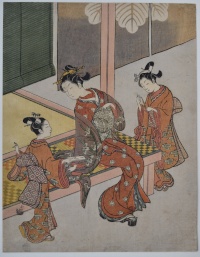
Click here to view image full size.
An unsigned chuban showing a seated courtesan with her two kamuro. One brings a letter while the other cleans her mistress’s tobacco pipe. Behind is a large kiri-mon on a noren. Published c. 1766-67. Other impressions in the Tokyo National Museum, Honolulu Academy of Arts and The Metropolitan Museum of Art. Rare.
Fine impression. Particularly well preserved colours: Most Harunobu prints sold are faded to some degree. Slight “turning” of the colour on the top of the noren and small smudge bottom left, otherwise very good condition.
Status: Available
Torii KIYONAGA (1752-1815)
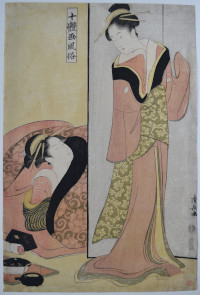
Click here to view image full size.
One of the great Ukiyo-e artists exemplifying what is called the classical school. He was a pupil of Kiyomitsu and was adopted by the Torii family, inheritating the estate, and was the last major member of the Torii School. From a set Jittai e-fuzoku, “Ten Forms of Manners in Pictures.”A fine design showing a standing beauty looking down at another girl who is raising herself from a futon. The grey back of a screen daringly cuts the design in two. Published by Takasu Soshichi, c. 1794. Provenance: Ex Vever collection (seal bottom right), sold Sothebys, Vever sale, Part 1, 26/3/1974, lot 165. This actual impression illustrated in the seminal Kiyonaga, Chie Hirano, MFA Boston, no. 969, pl. LXI. Another unidentified collector’s seal au verso. Rare.
Fine impression. Very good colour with yellow ground. Some expert restoration around edge, otherwise very good condition. Signed Kiyonaga ga.
Status: Sold
Kitagawa UTAMARO (1753-1806)
An aiban showing a mother and daughter from a set Tosei fuzoku hakkei, “Eight Views of Manners of Today.” This design probably referring to Mother’s Day. Another from the set is illustrated in Ukiyoe Zuten, no. 13, Utamaro, Kiyoshi Shibui, p. 107. Published by Izumiya Ichibei, c 1803.
Fine impression and colour. Minor mark au verso at top, otherwise fine condition. Signed Utamaro hitsu.
Status: Sold
Kitagawa KIKUMARO (c. 1753-1830)
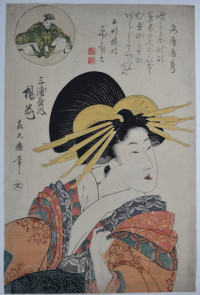
Click here to view image full size.
A bust portrait of the courtesan Agemaki of the Miuraya House compared to the poet Fun’ya no Yasuhide, one of the Six Immortal Poets (and shown in the roundel above). Obviously a set of six prints published by Maruya Bun’emon. It can be dated to 1802-4 because the character for kiku was changed from reading “chrysanthemum” (before 1802) to meaning “joy eternal” from 1802 to 1804 when he changed his signature to Tsukimaro. Yasuhide’s famous poem (no 22 in the Ogura Hyakunin Isshu) about the autumn wind blowing the leaves and grasses is at the top.
Very good impression, colour and condition. Signed Kikumaro fude.
Status: Sold
Kitagawa UTAMARO (1753-1806)
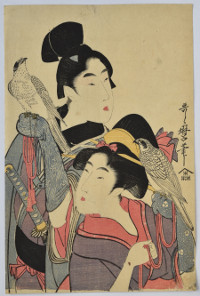
Click here to view image full size.
An aiban showing an elegant couple holding falcons. Takagari, Japanese falconry, is said – as so much else in Japan – to have come from China around the 4th century. A symbol of nobility and a status symbol. Published C 1803.
Fine impression with excellent colour. Minor mark extreme bottom right, otherwise fine condition. Signed Utamaro hitsu.
Status: Sold
Utagawa KUNISADA (1786-1864)
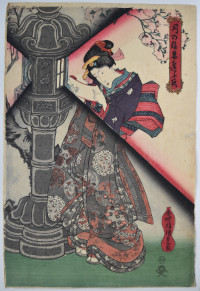
Click here to view image full size.
A stone lantern strongly illuminating a beauty reading a missive from a set Tsuki no kage shinobiau yoru, “Secret Meetings by Moonlight.” Published by Yamamotoya Heikichi c. 1836-38 and is based on strong light sources shining on beauties. This chiaroscuro technique was pioneered by Shumman and used by Utamaro and Toyokuni I.
Fine impression and colour. Small wormhole at right edge, otherwise very good condition. Signed Kochoro Kunisada ga.
Status: Sold
Utagawa KUNISADA (1786-1864)
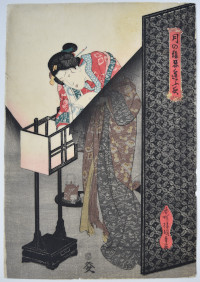
Click here to view image full size.
A woman putting out a floor lamp from a set Tsuki no kage shinobiau yoru, “Secret Meetings by Moonlight.” Published by Yamamotoya Heikichi c. 1836-38 and is based on strong light sources shining on beauties. This chiaroscuro technique was pioneered by Shumman and used by Utamaro and Toyokuni I.
Fine impression, colour and condition. Signed Kochoro Kunisada ga.
Status: Sold
Utagawa KUNIYOSHI (1797-1861)
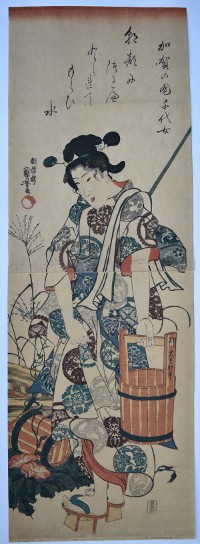
Click here to view image full size.
A vertical oban diptych showing the poetess Kagano Chiyo (1703-1775). The story relates how Chiyo goes to her well to draw water only to find that a morning-glory vine has overgrown her bucket. Rather than disturb it, she goes to a neighbour for water. This is the subject of a famous poem by Chiyo. Published by Izumiya Ichibei mid 1840s.
Very good impression and colour. Paper slightly toned and one light crease. Ample room for joining. Signed Chooro Kuniyoshi ga.
Status: Sold
Chobunsai EISHI (1756-1829)
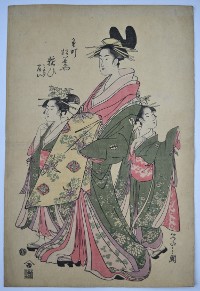
Click here to view image full size.
The parading courtesan Yosooi of Matsubaya with her kamuro Tomeki and Nioi. Published by Nishimuraya Yohachi c. 1800. She must have been a popular courtesan as she is depicted on many prints by various artists around this date.
Fine impression. Very good colour: Pale yellow ground. Very slight centre fold, otherwise very good condition. Signed Eishi zu.
Status: Sold
Suzuki HARUNOBU (1724-1770)

Click here to view image full size.
A pillar print showing a beauty after a bath walking past a pot of morning glory. Published c. 1768. The morning glory is a precursor of hot summer. Some 40 or 50 years later there was a craze for these plants almost akin to Dutch tulip fever. Other (faded) impressions are in MFA, Boston, Spaulding Collection, nr. 21.4552; Honolulu Museum of Art, nr. 06108; and illustrated in Waterhouse, The Harunobu Decade, 20013, nr. 545. Harunobu produced some of the most sublime Ukiyo-e images and he and his publishers were at the forefront of experimentation in the 1760s using multiple blocks, new pigments and combing pigments to create new hues that were not see again in Ukiyo-e. Unfortunately, the pigments – most often of vegetable origin – were very susceptible to fading and most Harunobu prints are ghosts of their former selves. Harunobu was a master of this hashira-e format: Jacob Pins found 111 to illustrate in The Japanese Pillar Print, 1982. Rare.
Fine impression. Exceptionally good colour. Minor soil but in very good condition for a print in this format and of this period. (These prints were hung in alcoves or on pillars and they consequently often come browned or faded as well as getting creased by being rolled.) Signed Harunobu ga.
Status: Sold
Yushido SHUNCHO (Fl. c. 1780-1795)
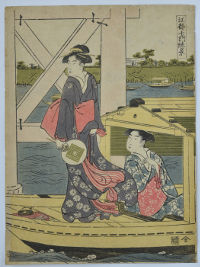
Click here to view image full size.
A chuban print showing beauties sight-seeing on the Sumida River. From a set of ten prints of views of Koto (an area of Edo bounded by the Sumidagawa to the west and Arakawa River to the east with many canals). Published by Enomoto, c. 1790.
Very good impression. Exceptionally well preserved colour: the fugitive pigments intact. Very slight soil, otherwise very good condition. Full size.
Status: Sold
Katsukawa SHUNSHO (1726-1792)
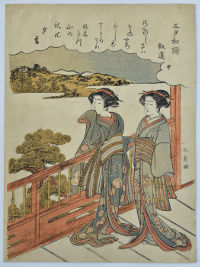
Click here to view image full size.
A chuban print from a set of three: Sanseki waka, “Three Evening Poems.” In this case interpreting a poem by Jakuren hoshi (1139-1202). The poem reads: Sabishisa wa / sono iro to shimo / nakarikeri / makitatsu yama no / aki no yugare, Loneliness / is not / any particular colour – / a mountain of black pines / on an autumn evening. The other two prints probably have poems by Teika and Saigyo. Shows beauties on a balcony admiring the pines in the distance. Published c. early 1770s. Ex collection Erik Holmberg. Rare.
Very good impression. Particularly good colour with pigments that have usually turned. Very good condition. Signed Shunsho ga.
Status: Sold
Isoda KORYUSAI (1735-1790)

Click here to view image full size.
A pillar print, hashira-e, of a beauty after a bath cooling herself with a fan. A cat looks up adoringly from below. Above her is a temple bell wind chime, often hung in the summer. Masanobu laid claim to have invented the pillar print format. Roger Keyes has suggested that, because many large format prints from the 1740s were printed using two blocks of wood, there was a tendency for the blocks to separate during use, giving rise to the hashira-e shape. Probably the most interesting format in that the restrictions often led to creative compositions. And figures sometimes partially exit or enter from the side, giving weight to the theory of separating blocks of wood. Certainly, these prints were hung on pillars in houses, and because of this they often come browned, faded or damaged. Koryusai was the artist par excellence when it comes to pillar prints. Rare.
Very good impression and colour. Slight toning, but in very good condition for such a print. Signed Koryusai ga.
Status: Sold
Katsukawa SHUNCHO (Active 1780-1795)
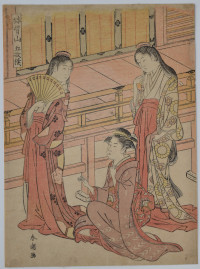
Click here to view image full size.
A chuban print from a set of five designs: Imoseyama gomai tsuzuki, “Imoseyama, a Set of Five Prints.” Shows two court beauties and an attendant. Based on the Bunraku play Imoseyama onna teikin, “Husband and Wife Mountain: An Exemplary Tale of Womanly Virtue” which was performed for the first time in 1771. It was then adapted for the Kabuki theatre. The play is in five acts.
Very good impression, colour and condition. Signed Shuncho ga.
Status: Sold
Utagawa SADAHIDE (1807-1873)
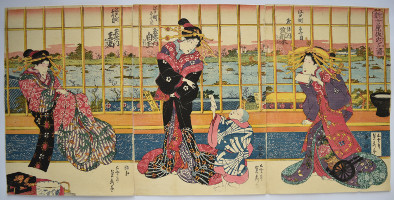
Click here to view image full size.
A triptych, Shin Yoshiwara karitaku no zu, “Temporary Lodgings of the New Yoshiwara.” Shows the courtesans Shiratama, Masanagi, and Tamakazura of the Tamaya House before a latticed window overlooking the Ryogoku River. The Tamaya was one of the best known brothels. Their kamuro are listed beside their names. Published c. 1843-7 by Yamaguchiya Tobei. Rare: I cannot locate another impression.
Very fine impression, colour and condition.Signed Gountei Sadahide ga.
Status: Sold
Kikugawa EIZAN (1787-1867)
Click here to view image full size.
The courtesan Biso of the Ogi House holding a brush up to a snow sculpture of Daruma. Snow from a Snow, Moon, Flowers set: Seiro bijin setsugekka. Published by Kawaguchiya Uhei, c late 1810s.
Fine impression. Very good colour. Fine condition: Full size with extra paper. Signed Eizan hitsu.
Status: Sold
Kikugawa EIZAN (1787-1867)
Click here to view image full size.
Winter from a set Furyu bijin kodakara awase, “Elegant Beauties and Precious Children.” Shows a beauty carrying one child and looking down at another with a large snowball. Published by Matsumura Yahei, c late 1810s.
Fine impression. Very good colour. Fine condition: Full size with extra paper. Signed Eizan hitsu.
Status: Sold
Tsukioka YOSHITOSHI (1839-1892)
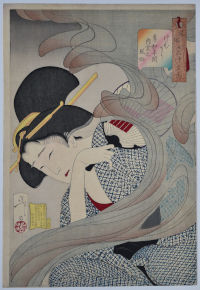
Click here to view image full size.
Kemu-so: Kyowa nenkan naishitsu no fuzoku, “Looking Smoky:The Appearance of a Housewife of the Kyowa Era.” From the set: Thirty-Two Aspects of Women published by Tsunashima Kamekichi, 1888. Shows a housewife fanning a smoldering fire probably intended to repel summer insects. The best design from the set.
Very fine impression, colour and condition of the first edition. The gradation and printing of the smoke is particularly accomplished. Signed Yoshitoshi ga.
Status: Sold
Kitao MASANOBU (Santo KYODEN) (1761-1816)

Click here to view image full size.
One double-oban design from the most sumptuous album ever produced: Yoshiwara keisei: Shin bijin awase jihitsu kagami, “A Mirror of New Yoshiwara Courtesans with Samples of Their Calligraphy.” Published by Tsutaya Juzaburo, 1784. Shows courtesans viewing calligraphic scrolls. Seven double-oban designs were published in album form, although the original intention was for a larger set. Signed on two sheets Kitao sensai Masanobu.
Fine impression. Extremely good colour. Centre fold (as always), several very small wormholes and minor marks, but otherwise in very good condition.
Status: Sold
Hosoda EISHI (1756-1829)
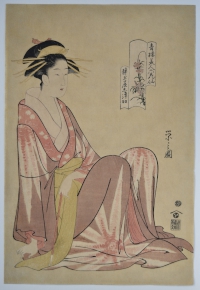
Click here to view image full size.
The courtesan Shizuka of the Shizutama-ya from the set of six prints Seiro bijin rokkasen, “Six Poems on Yoshiwara Beauties as Flowers.” One of the most beautiful sets of this period. Published 1794 by Nishimuraya Yohachi (Eijudo). The centre cartouche has a seasonal bloom, in this case the pink which was the emblem of Shizuka. See Klaus Brandt, Hosoda Eishi, 1977, 51, no. 172. Another impression was in the Popper sale catalogue, no. 138 and the impression from the Museum fur Ostasiatische Kunst, Berlin, is illustrated in the 1974 Tokyo Exhibition catalogue, no. 146.
Fine impression. Very good colour and condition. Yellow ground and mica on collar. Signed Eishi zu.
Status: Sold
